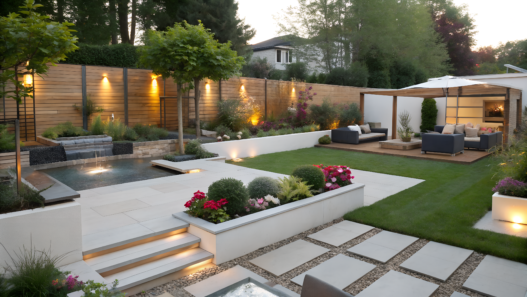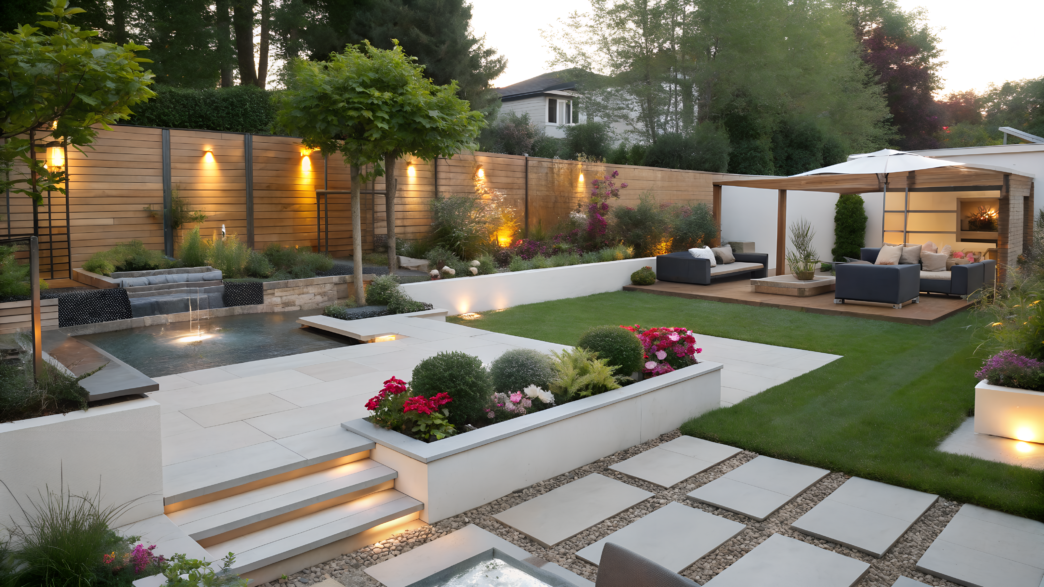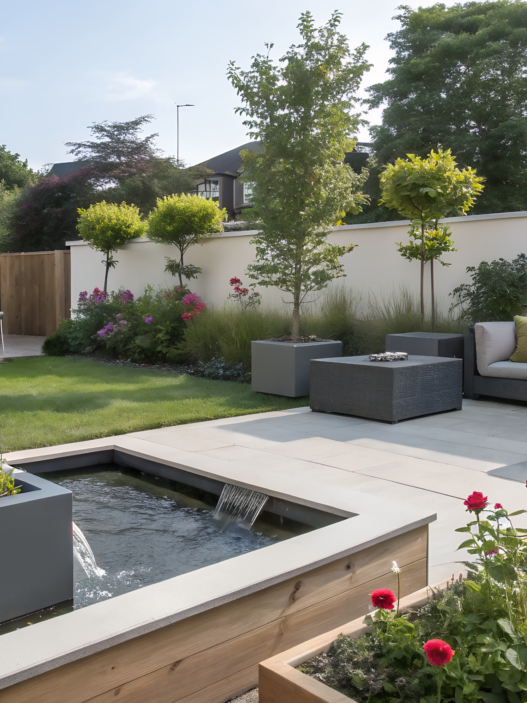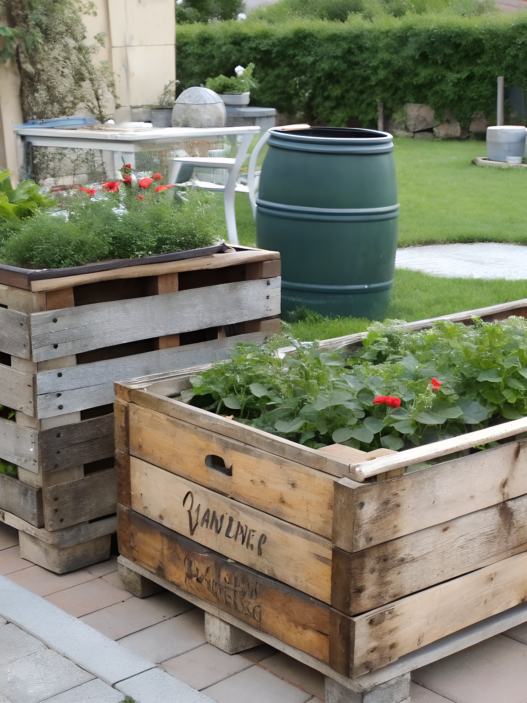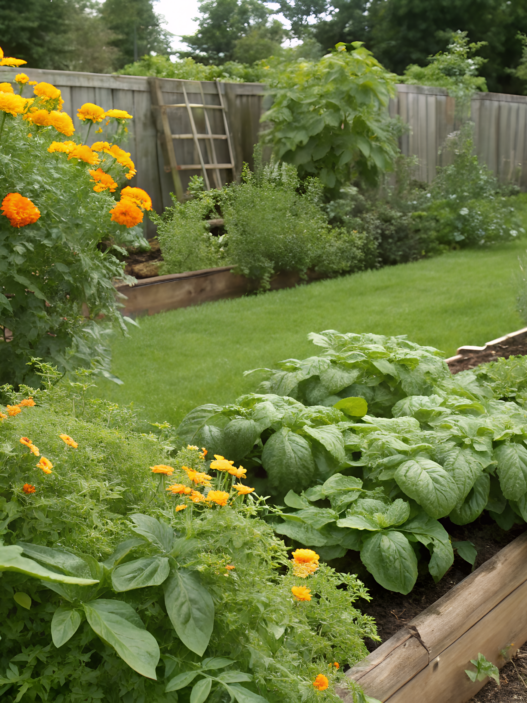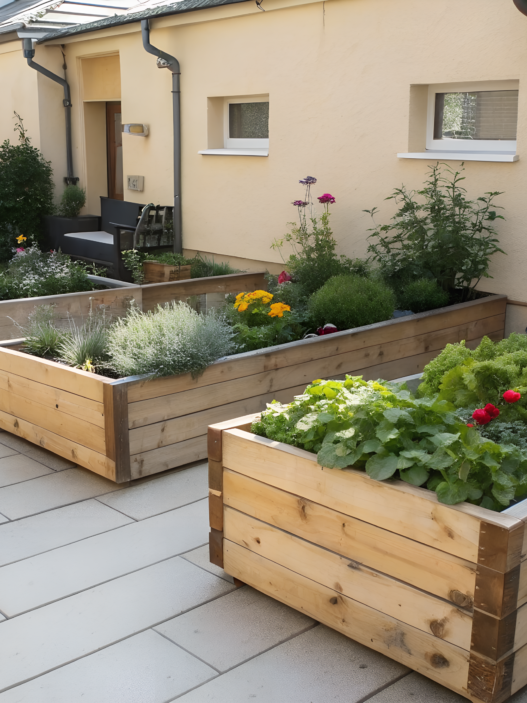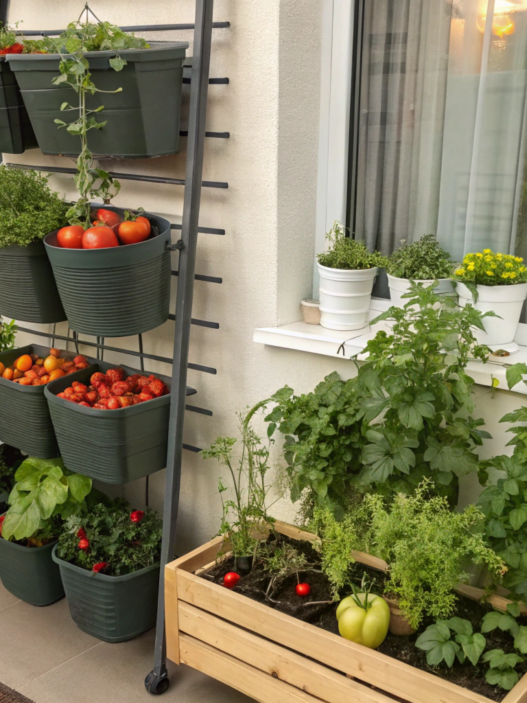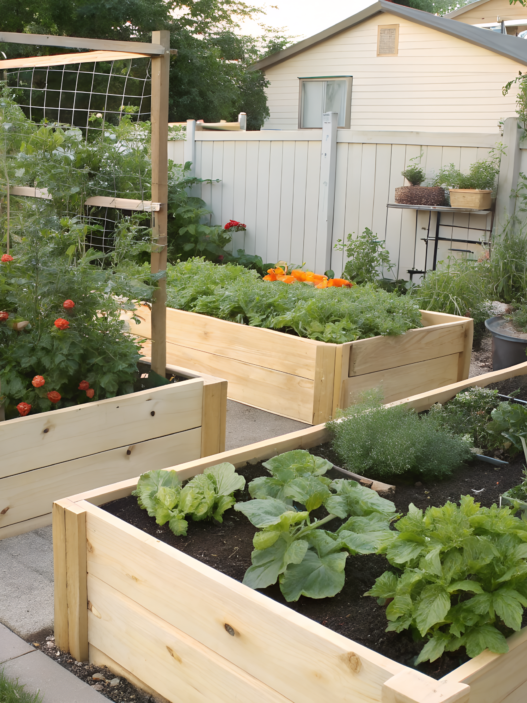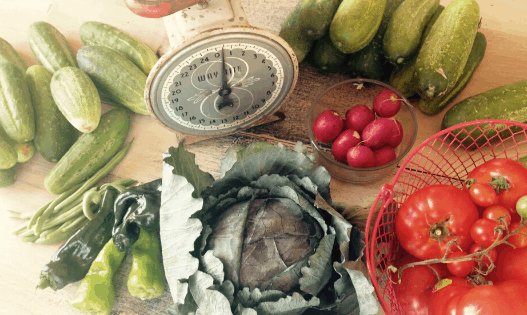A modern garden is not just about flowerbeds and paths, but a stylish and functional space that brings joy and, if possible, looks like something out of a design magazine. We’d all like that. But what do you do if you don’t have the budget for a landscape designer? Of course, we are perfectly capable of transforming our yard on our own! Here are 15 modern garden ideas to help turn your lot into a stylish and comfortable place. The methods will be very different, and I think everyone will be able to find something suitable for themselves.
DIY Backyard Landscaping Hacks That Make Any Space Look Professionally Designed
1. Gravel and tiles for zoning. Stylish contrast without spending a lot of money
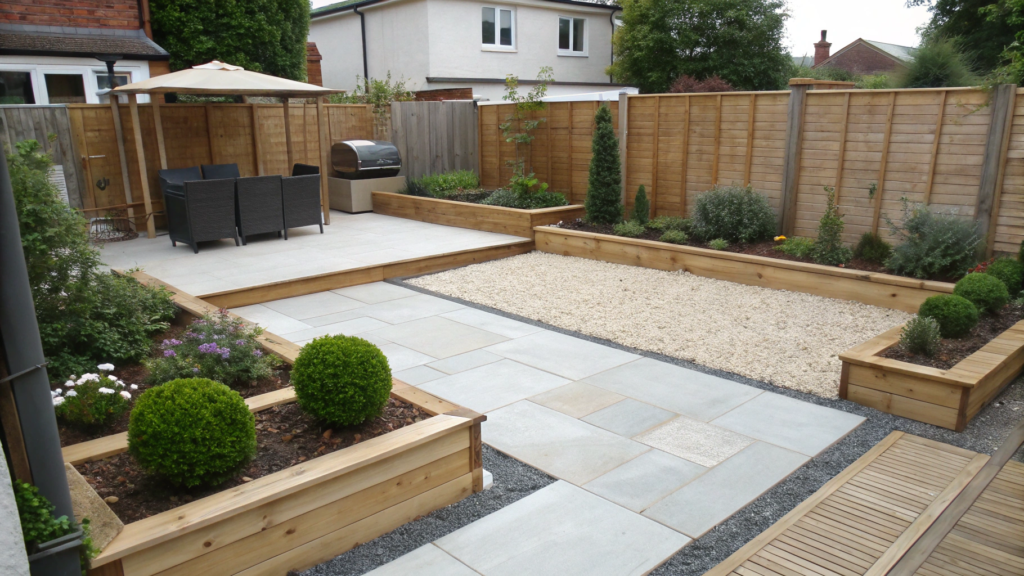
Any plot of land can be turned into an elaborate garden easily if you set the right accents. One of the easiest techniques is to combine different coverings, for example, gravel and tiles.
How to do it.
- Determine the main areas of the garden: a place to relax, a grilling area, and beds.
- For convenience, you can sketch a plan (drawing on paper or layout in the appendix).
- In the recreation area, use light-colored gravel or wooden decks, and place natural stone tiles nearby.
- Boundaries between zones can be made with curbs or small decorative hedges.
This technique allows you to set the structure of the space, making it stylish and thoughtful. It looks especially good if you want to design a plot in a modern minimalist style, where natural materials are used.
Tip. So that the gravel coating does not spread all over the garden, use geotextile under the base. And gravel can also be combined with garden slabs to create patterns or stylish paths.
For example, you can use this garden gravel – it’s easy to lay and looks great in the garden.
2. Vertical gardening: walls, suspended structures and green facades

As an unusual accent you can use vertical gardens – this is something that works well when there is little space. .They create depth in a space, and by the way, can be quite functional. For example, you can grow spicy herbs.
How do you implement this idea in your garden?
- Wooden or metal grids on walls or fences. You can hang planters with ampelike plants such as petunias or ivy.
- Fabric plant pockets. You can grow not only ornamental but also edible crops, such as strawberries or basil.
- Green walls. For this purpose, you should use constructions with cells for plants, where you can plant different types of flowers or even dwarf shrubs.
Tip. Excellent for vertical gardening succulents, ferns, ivy and even dwarf fruit trees. And here is an example of hanging planters for a vertical garden, very easy to install.
3. Decorative partitions made of wood and metal
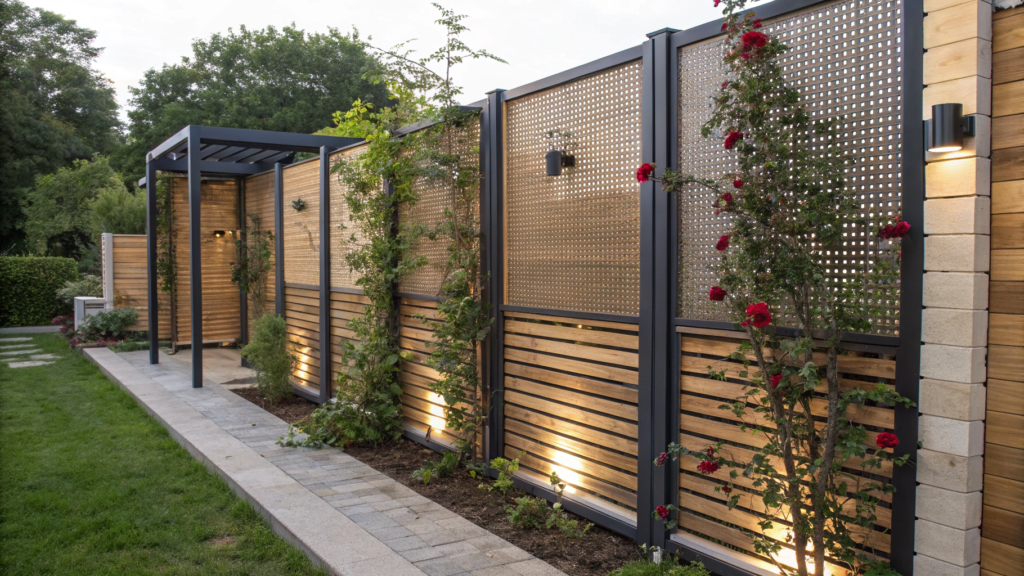
Landscape designers often use a combination of wood and metal to create stylish garden partitions. This is not only beautiful, but also functional, since such partitions zoned space, protect from the wind and curious neighbors.
How to do it?
- You can use horizontal wooden slats (as in Japanese gardens) or perforated metal panels.
- If you want more naturalness and naturalness, add greenery along the partition (e.g. a climbing rose or grapes).
- Built-in LED lighting will come in handy for pleasant illumination.
The trick. Such partitions are often made removable or foldable, so that you can change the configuration of the garden.
4. Ponds and mirrors. A modern technique for increasing space
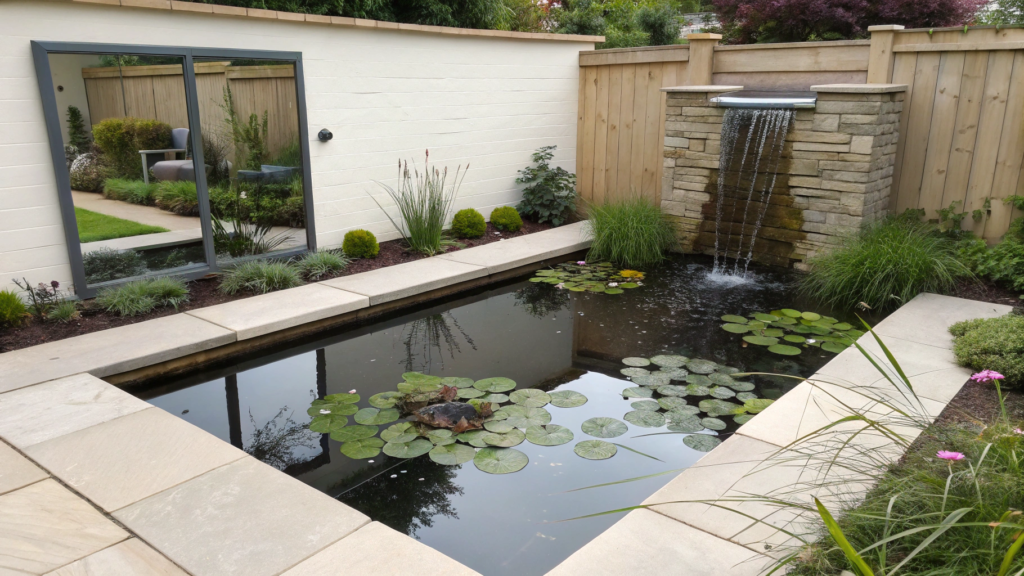
We will not overload the garden with decorative elements, but properly placed water surfaces can radically transform the site. A small pond, a reflective mirror or even a mini fountain add depth, dynamics and balance.
How to do it?
- A minimalist pond. Dig a shallow container into the ground and cover it with natural stone. Additionally, you can add lily pads and bog plants. If the pond is deep enough (80 cm or more), you can even have koi carp in it.
- Mirrors in the garden. You’ll see that this is a great trick for visually expanding space. Place a mirror panel on a fence or house wall opposite a flowerbed, and the garden will look twice as big.
- Wall-mounted waterfall. Not at all unnecessary soothing noise of water, for this you can install a narrow vertical cascading structure on one of the retaining walls.
Tip. Water features and mirrors are best placed in shaded areas so they don’t overheat in the sun. Great examples of compact modern garden fountains.
Genius Ways to Use Retaining Walls in a Modern Garden (You’ll Want to Try These!)
Retaining walls are known to protect against soil slumping and also provide an opportunity to add stylish and functional elements to the landscape. They can be a decorative border, a nice place to relax or even a place to grow plants. Let’s try to figure out how to make the most of them.
5. Terracing. Creating a multi-layered garden
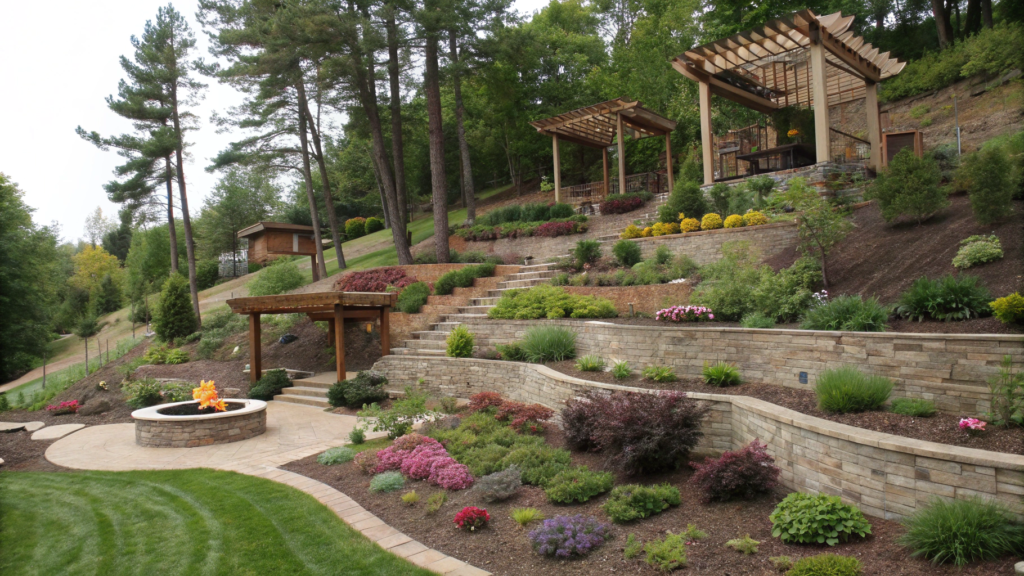
If your plot of land is sloping, instead of fighting it, you can use the different levels of terrain to your advantage. Properly organized terracing will prevent soil erosion, and make the plot visually more interesting.
How does it work?
- Upper Level. Great for tall trees, ornamental shrubs, or even a small orchard. You can add a pergola or gazebo to create a shady nook.
- Middle Level. This is the place for beds with perennials, flowers or beds with vegetables. You can make beautiful mix-borders with a combination of plants of different heights.
- Lower level. And here it is ideal to place a recreation area, a fire pit or a small lawn, where you can spread a plaid and just enjoy nature.
Tip. As retaining walls, you can use natural stone (for a classic look), concrete blocks (for a modern design) or even wooden sleepers (for eco-style).
6. Retaining walls as built-in benches
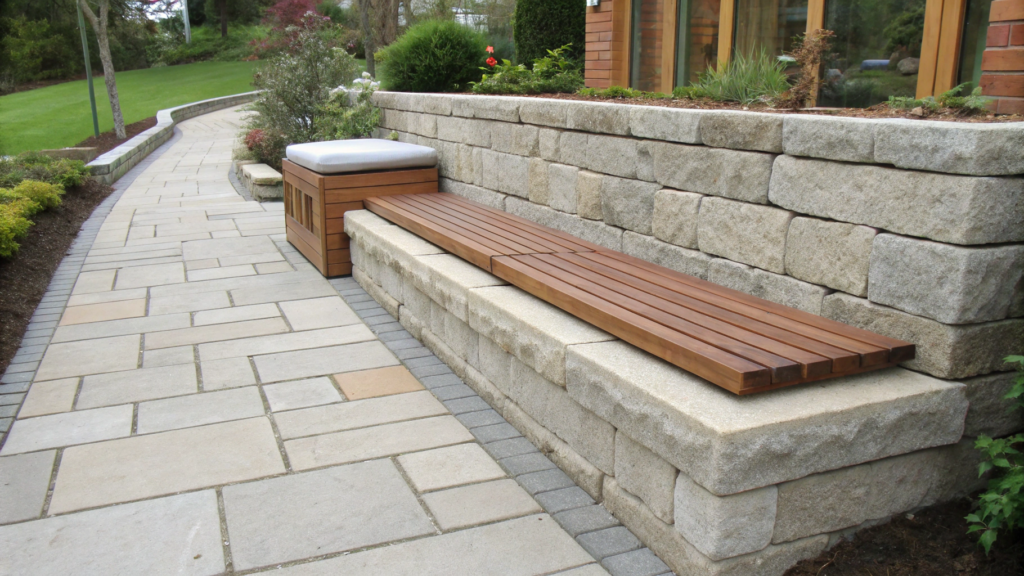
You’d be surprised, but a retaining wall can not only hold soil, but also serve as a comfortable place to sit.
How to do it.
- Build a low retaining wall 40-50 cm high. It is best to use stone blocks, concrete or bricks to make the structure strong and durable.
- Add a wooden seat – lay treated planks of larch, teak or acacia on top (they are resistant to moisture).
- For comfort, put soft cushions or you can make seats with a hinged lid to use the space inside the wall as a place to store garden tools or plaids.
This solution saves space and makes the garden more comfortable for relaxing. Check out this option of stylish garden cushions, they are moisture resistant and suitable for outdoor conditions.
7. Mini garden on a retaining wall. Vertical gardening with maximum benefit
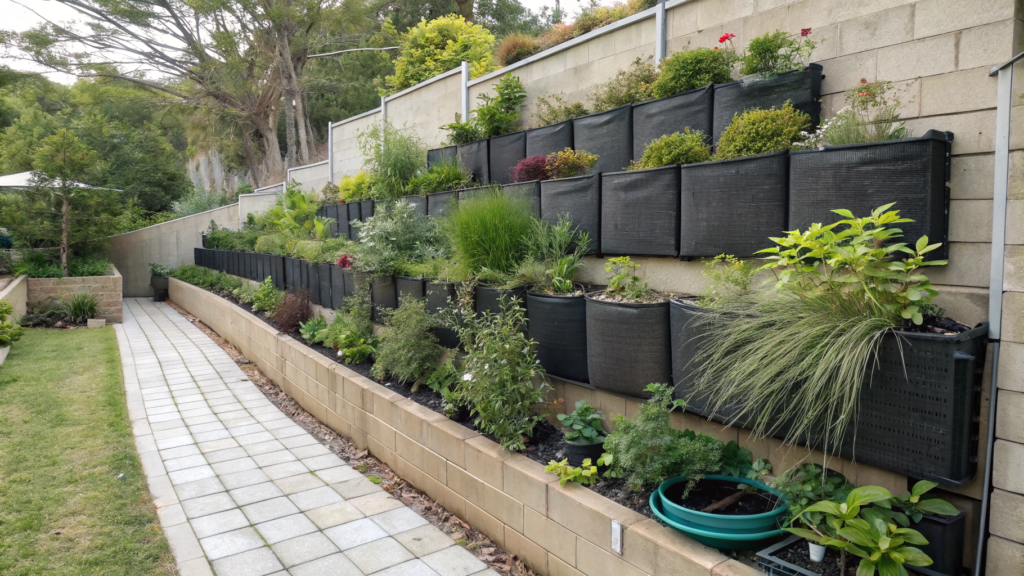
If you already have a retaining wall (or are planning to build one), let’s make a green art object out of it.
Retaining walls are good for vertical gardening, especially if you build containers or special plant pockets into them. Such a technique beautifies the space and adds extra insulation and protection from overheating.
How it works.
Built-in containers in the wall
- If the wall is being built from scratch, you can immediately provide small “pockets” or cascading niches in the masonry. These are perfect for low growing plants or even grasses.
Suspended pockets or cachepots
- If the retaining wall is already standing, you can attach wall pots or fabric modules to it. They are attached to special brackets and create the effect of a living carpet. It looks very beautiful and original.
Drip irrigation system
- It is not superfluous to install a drip irrigation system on the retaining wall. This is a convenient way to maintain humidity, especially in the summer heat.
What kind of plants would work best?
- Succulents. Ochitki (sedums), aeoniums, milkweed – will fit well in small niches and do not require constant care.
- Lavender. Not only looks beautiful, but will also give the site a kind of Mediterranean style.
- Ferns. They will take root well in shady areas, creating a “forest wall” effect.
- Spicy herbs. Thyme, rosemary, mint or even strawberries. Sounds really delicious!
The trick. You can combine different plants to create colorful vertical compositions. For example, plant lavender in the center and add sedums and thyme on the sides.
8. Retaining walls with niches for the fire area
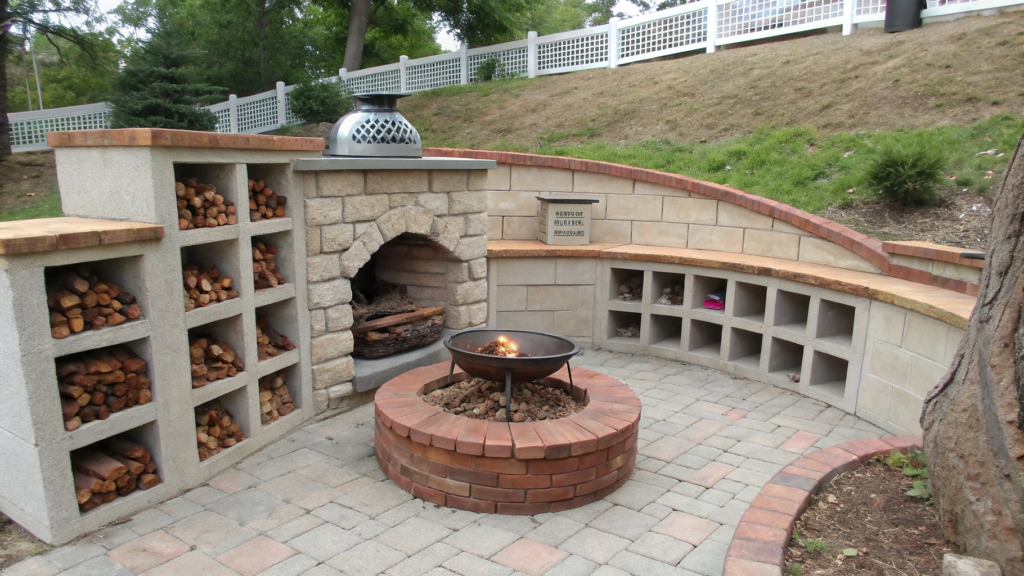
If you combine a retaining wall and a campfire area, you get quite stylish and functional, especially if you like to gather with friends.
How to implement it?
- Built-in hearth. In the center of the retaining wall, you can leave a niche and install there a metal bowl for the fire (it is important that it has legs, that is, not standing directly on the base of the niche). Be sure to provide ventilation holes (3-5 cm) in the side or rear walls to avoid overheating and ensure a good draft. Also, don’t forget to leave a 5-10 cm gap around the hearth for air circulation.
- Wood-burning niches. If you make a wall of brick or concrete blocks, provide open shelves in its lower part for storing firewood – it’s convenient and adds coziness.
- Semi-circular wall. If you make a retaining wall in a semicircle around the fire pit area, you’ll get a natural windbreak and a cozy space to relax.
Tip. Use heat-resistant materials – fireclay bricks, concrete with expanded clay or natural stone – to avoid cracking of the structure from high temperatures.
The Best Plants for a Contemporary Backyard Landscaping Look (Low Maintenance!)
Let’s figure out which plants are best for a stylish but unpretentious garden. We don’t want to spend hours weeding and pruning plants, do we?
9. Grasses: Dynamics and volume without the hassle

If you want to add a natural airiness to your garden, you can’t do without grasses. They look great both in flowerbeds and along paths or walls.
- Miscanthus sinensis is a tall ornamental grass with graceful spikes. In fall, it turns reddish-orange hues.
- Imperata cylindrica ‘Red Baron’ – a bright red grass that stands out spectacularly against the green background.
- Blue fescue is a compact grass with a bluish-silver hue. Just perfect for borders.
How to use them?
- Plant next to garden paths to create a dynamic effect.
- Use in stone or gravel gardens because herbs look great in a minimalist design.
- Combine with succulents for a contrasting texture.
10. Evergreen shrubs: green all year round
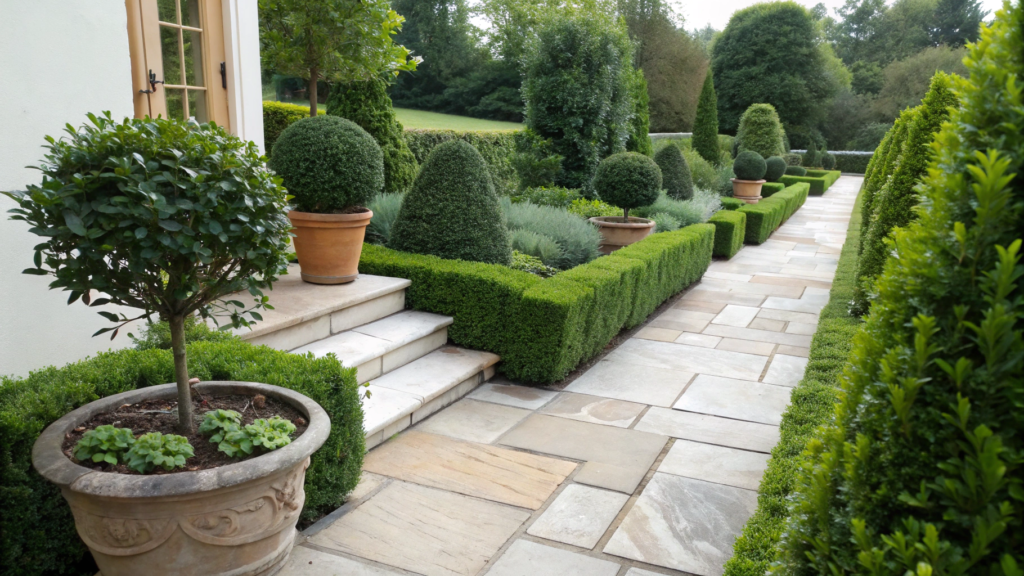
In winter, a garden can look empty and lifeless, especially if only summer flowers and annuals dominate. But evergreen shrubs solve this problem by giving structure, depth and a stylish appearance all year round. They do not require complicated maintenance and combine perfectly with ornamental perennials and conifers.
- Boxwood. It is easy to shear, it can be used to form hedges, geometric shapes and even to create stylish topiaries. It looks great in minimalist and French gardens.
- Laurel. A magnificent shrub with glossy leaves that looks great in modern landscape compositions. It grows quickly, tolerates shearing and is ideal for creating hedges.
- Berry yew. A coniferous shrub that will give your plot an expensive “English” style. It grows slowly, but requires little maintenance.
Where should I plant them?
- Along paths or borders. This way they will create clean lines and zoning.
- In pots for mobile patio gardening. For example, boxwood spheres in ceramic planters are perfect for any patio.
- As a backdrop for flower beds. To make seasonal flowers look even brighter, dark green shrubs will create a contrasting backdrop for them.
11. Drought-tolerant plants: beautiful without watering
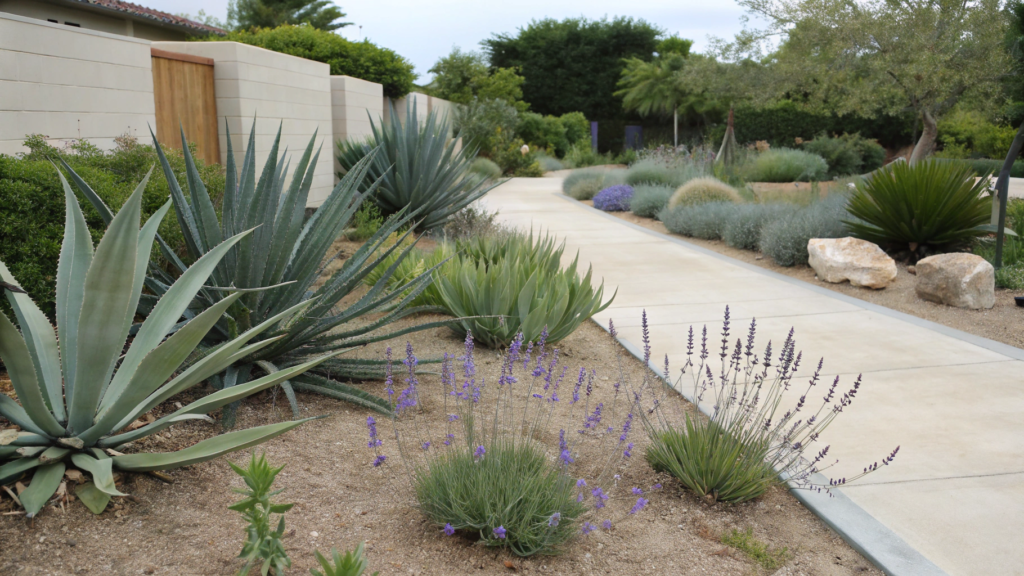
If you’re not a big fan of daily watering, I recommend looking at drought-tolerant plants. Not only can they survive with minimal care, but they can also create a unique style.
Agaves and yuccas. Look almost sculptural with their powerful, pointed leaves. They fit perfectly into minimalist and natural landscapes, requiring minimal care.
- Agaves and yuccas can be planted in gravel beds or in large containers.
Cleavers (sedums). If you need groundcover plants that fill in empty spaces and suppress weed growth, cleavers are just the thing. They don’t fear drought, grow quickly and even bloom in conditions where other plants would have withered away long ago.
- They can be planted along garden paths.
Lavender. It’s hard to imagine a Mediterranean-style garden without it. Its blue-violet inflorescences and fragrant leaves create a calm atmosphere and attract bees and butterflies to the garden.
- Lavender looks great along paths, by the terrace or in pots.
Tip. Drought-tolerant plants do best in sandy or stony soil. If the soil is too dense, add perlite, gravel or coarse sand to ensure good drainage.
12. Ornamental conifers for a stylish garden framework
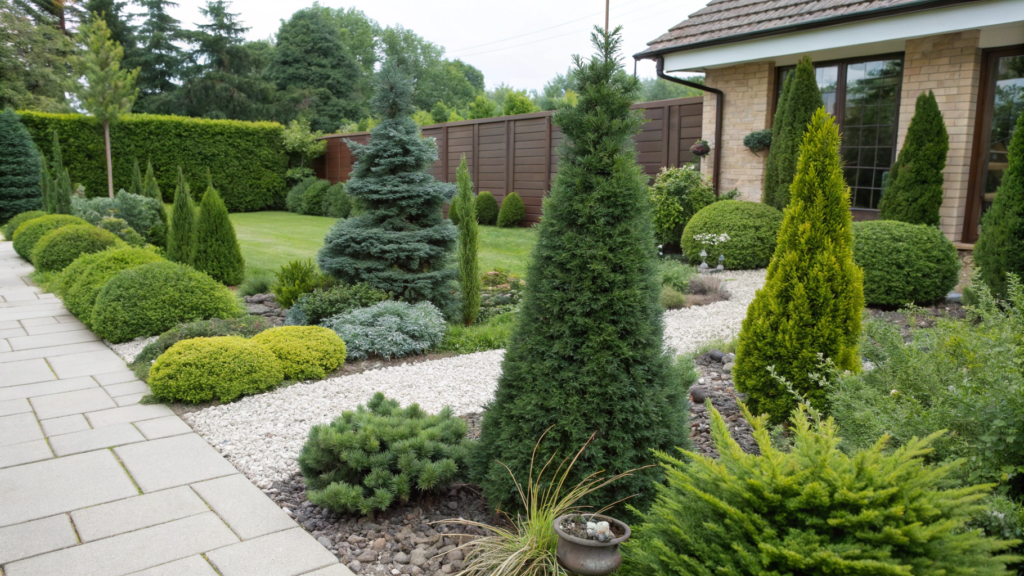
Not only shrubs and perennials, but also coniferous trees make the garden lively and structured at any time of year. They can serve as centerpieces in the landscape, frame paths or even replace a fence.
Unlike deciduous trees, conifers keep their green color even in winter, which means your plot won’t turn into a dreary space during the colder months.
But which conifers are best for the modern garden?
- Dwarf spruce (Picea glauca ‘Conica’). This compact, neat tree is ideal for borders and accents. It grows slowly, does not require frequent pruning and looks great along paths or in containers at the entrance.
- Thuja occidentalis ‘Smaragd’. If you need a slender hedge that doesn’t sprawl, this tree is the best choice. It is frost-resistant, easy to shear and retains its rich green color even in winter.
- Juniper stemmed (‘Blue Star’ or ‘Wiltonii’). Low-growing, dense and almost maintenance-free. Looks great in gravel areas, alpine gardens and along paths.
- Mountain pine (Pinus mugo). The ideal choice for minimalist gardens. Its soft needles create a wilderness feel, especially when combined with pebbles or mulch.
Some conifers can be planted in containers, which means you can always change the structure of the garden by simply rearranging them without a problem.
Tip. Conifers can be mixed with ornamental grasses and perennials to create a layered effect.
Here are seedlings of dwarf conifers. They are great for small plots.
DIY Backyard Pathways That Transform Any Garden into a Design Masterpiece
Well-designed garden pathways can revolutionize the look of a garden. They not only make it easier to move around the garden, but also create a stylish geometry.
13. Gravel paths with stone slabs. Elegance without spending too much
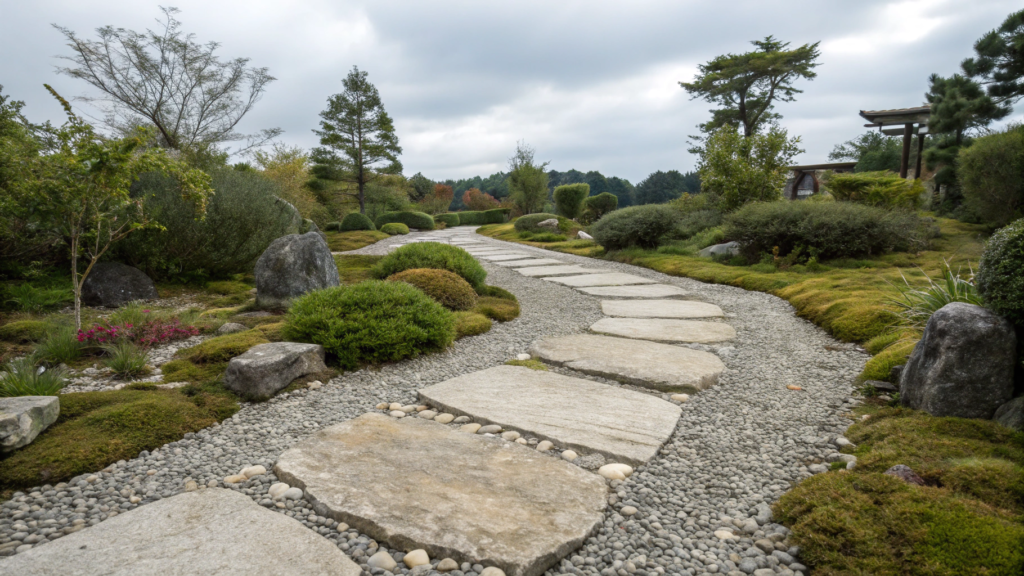
Here’s a simple but very effective idea for you: the combination of gravel and individual large slabs creates a feeling of lightness and naturalness.
How to do it?
- Mark out the place for the path and remove a layer of earth (5-10 cm).
- Fill the base with sand, then gravel.
- Place large flat stones at an equal distance from each other.
- Between the slabs you can plant moss or ground cover plants.
Such a path looks especially effective in gardens in the Scandinavian or Japanese style.
14. Wooden spiles path: eco-style with your own hands
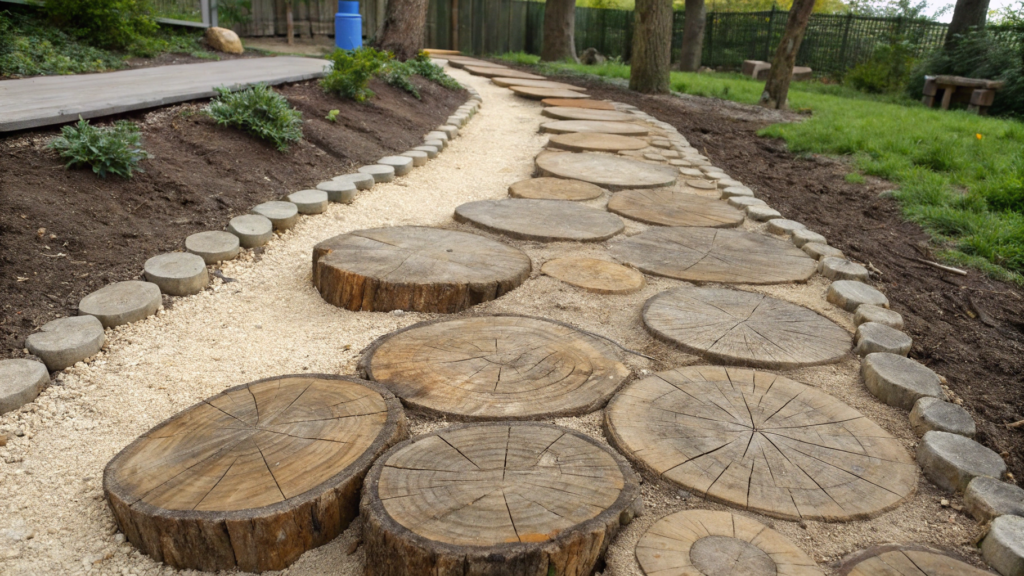
Fans of natural materials, I propose to make a path from tree spiles. It will fit perfectly into the natural landscape.
How to make it?
- Saw the logs into disks 10-15 cm thick (it is desirable to use oak or acacia, as they are durable).
- Dry and treat with antiseptic (to prevent rotting).
- Lay the spiles on a sandy base, fill the gaps with fine gravel or bark.
Tip. Combine different diameters of spiles. This way the path will look more natural.
15. Luminous paths: fantastic effect without electricity

If you want to add spectacular illumination to your garden, but without wiring and electricity costs, try using glow-in-the-dark pebbles. It’s a really original solution that gives the garden a magical look in the evening.
What’s the point? These stones are coated with a special luminescent composition, which is charged with sunlight during the day, and at night glows with a soft bluish or green hue.
How to make a luminous walkway with your own hands?
- Choose a place for the path. If you already have a finished walkway made of gravel or stone, add glowing stones on top. If the walkway is just being created, you can mix regular gravel with luminescent stones.
- Mix materials. To achieve a natural effect, you shouldn’t lay the luminous stones in a solid layer. It is better to mix them with regular pebbles or stones to make them look like “glowing islands”.
- Let them “recharge.” The more daylight the stones get, the brighter they will glow at night. They can work even in cloudy weather, but the best effect will come from direct sunlight.
- Secure the effect. If the stones are on a loose surface (like gravel), you can lightly tamp them down or use a thin layer of clear varnish to keep them in place longer.
Check out these glowing stones – they’re great for creating unusual garden paths.
The trick. Glowing stones look particularly effective in Japanese or nature-inspired gardens, where unobtrusive design elements create a unique atmosphere.
What do you think of these ideas?
Don’t forget that creating a stylish modern garden is realistic even without huge expenses. Maybe you have already tried some of these?
Share your thoughts and plans in the comments! The main thing is a little imagination and a desire to make your space beautiful!
